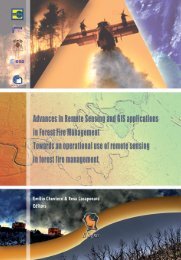EARSeL Newsletter - EARSeL, European Association of Remote ...
EARSeL Newsletter - EARSeL, European Association of Remote ...
EARSeL Newsletter - EARSeL, European Association of Remote ...
Create successful ePaper yourself
Turn your PDF publications into a flip-book with our unique Google optimized e-Paper software.
<strong>EARSeL</strong> <strong>Newsletter</strong> September 2002 - Number 51<br />
20<br />
lumbia, originally scheduled for July, has<br />
been put back to next January. For further<br />
information, see www.space.com/missionlaunches/ap_atlantis_020911.html.<br />
Still on the subject <strong>of</strong> the Space Shuttle,<br />
digital topographic data <strong>of</strong> the USA, obtained<br />
by the Shuttle Radar Topography<br />
Mission and released to the public in early<br />
2002, can be accessed via the web-sites<br />
www.jpl. nasa.gov/srtm/cbanddataproducts.html<br />
and edcsgs9.cr.usgs.govpub/<br />
data/srtm.<br />
4.6 Satellite survey reveals<br />
"greening" Sahara<br />
On 18th September 2002 it was reported on<br />
the web-site <strong>of</strong> the British magazine New<br />
Scientist (www.newscientist.com/news),<br />
that an analysis <strong>of</strong> satellite imagery <strong>of</strong><br />
Africa’s deserts has revealed that the<br />
southern Saharan desert is in "spectacular<br />
retreat", making farming viable again in<br />
what were some <strong>of</strong> the most arid parts <strong>of</strong><br />
Africa. Burkina Faso, one <strong>of</strong> the West<br />
African countries devastated by drought<br />
and advancing deserts twenty years ago, is<br />
growing so much greener than families<br />
who fled to wetter coastal regions are starting<br />
to go home. New research confirming<br />
this remarkable environmental turnaround<br />
is to be presented to Burkina Faso's<br />
ministers and international aid agencies in<br />
November 2002.<br />
And it is not just Burkina Faso. New Scientist<br />
has learned that a separate analysis <strong>of</strong><br />
satellite images completed this summer reveals<br />
that dunes are retreating right across<br />
the Sahel region on the southern edge <strong>of</strong><br />
the Sahara desert. Vegetation is ousting<br />
sand across a swathe <strong>of</strong> land stretching<br />
from Mauritania on the Atlantic, to Eritrea,<br />
6000 kilometres away on the Red Sea coast.<br />
Nor is it just a short-term trend. Analysts<br />
say the gradual greening has been happening<br />
since the mid-1980s, though it has gone<br />
largely unnoticed. Only now is the evidence<br />
being pieced together.<br />
Aerial photographs taken in June 2002<br />
show "quite spectacular regeneration <strong>of</strong><br />
vegetation" in northern Burkina Faso, according<br />
to Chris Reij <strong>of</strong> the Free University,<br />
Amsterdam. There are more trees for firewood<br />
and more grassland for livestock.<br />
And a survey among farmers shows a 70<br />
per cent increase in yields <strong>of</strong> local cereals<br />
such as sorghum and millet in one province<br />
in recent years. The survey, which Reij is<br />
collating, was paid for by Dutch, German<br />
and American overseas aid agencies. Meanwhile,<br />
Kjeld Rasmussen <strong>of</strong> the University <strong>of</strong><br />
Copenhagen has been looking in detail at<br />
sand dunes in the same area. Once they<br />
seemed to be marching south. But since the<br />
1980s, he says, there has been a "steady reduction<br />
in bare ground" with "vegetation<br />
cover, including bushes and trees, on the increase<br />
on the dunes".<br />
Desertification is still <strong>of</strong>ten viewed as an irreversible<br />
process triggered by a deadly<br />
combination <strong>of</strong> declining rainfall and destructive<br />
farming methods. In August 2002,<br />
the UN Environment Programme (UNEP)<br />
told the World Summit in Johannesburg<br />
that over 45% <strong>of</strong> Africa is in the grip <strong>of</strong> desertification,<br />
with the Sahel worst affected.<br />
But a team <strong>of</strong> geographers from Britain,<br />
Sweden and Denmark has spent the summer<br />
re-examining archive satellite images<br />
taken across the Sahel. Andrew Warren <strong>of</strong><br />
University College London told New Scientist<br />
that the unpublished analysis shows<br />
that "vegetation seems to have increased<br />
significantly" in the past fifteen years, with<br />
major re-growth in southern Mauritania,<br />
northern Burkina Faso, north-western<br />
Niger, central Chad, much <strong>of</strong> Sudan and<br />
parts <strong>of</strong> Eritrea. But there is confusion over<br />
why the Sahel is becoming green. Rasmussen<br />
believes the main reason is increased<br />
rainfall since the great droughts <strong>of</strong><br />
the early 1970s and 1980s. But farmers have<br />
also been adopting better methods <strong>of</strong> keeping<br />
soil and water on their land. (This article<br />
is from a report by Fred Pearce at<br />
www.newscientist.com/news/news.jsp?id<br />
=ns99992811).<br />
4.7 Satellites show Earth’s growing<br />
waistline!<br />
According to a report on 1st August 2002,<br />
satellite data since 1998 indicate that the<br />
bulge in the Earth's gravity field at the<br />
equator is growing, and scientists think
















